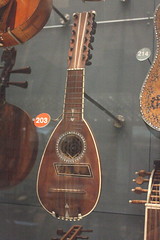-
Fetches news & information

 Flickr.com - Mandolins, Bouzoukis, etc. [Necked Bowl Lutes] 17: M
Flickr.com - Mandolins, Bouzoukis, etc. [Necked Bowl Lutes] 17: M
KM's Live Music shots has added a photo to the pool:

21st July 2016 at Horniman Museum, London SE23.
The Mandolin evolved from the Lute via the Mandore in 17th and 18th century Italy. It became popular in the United States in the mid 19th century, where folowing an instrument produced in 1905 by Orville H. Gibson it adopted a flat back rather than the bowl shaped one. The bodies of modern Mandolins can be either pear shaped or tear drop shaped (i.e. with a scroll carved into the headstock). They also vary in the shape and position of the sound holes which impacts on the sound of the instrument.
In 17th century Italy Mandolins adopted different styles based on diferent regions of the country e.g. Milanese, Lombardic, Roman, Cremonese, Brescian, Genoese, Neapolitan before the last became the dominant style.
The Genovese Mandolins were hybrids between the Mandore and the Neapolitan Mandolin. They had six pairs of gut strings rather than metal ones, and were shorter and with a with a shallow back than the Napolitan mandolin.
This instrument was made in the second quarter of the 18th Century by Cristiano Nonemacher in Genoa, Italy. It has Six double courses of wire strings.
Mandolins are assigned the number 321.321 in the Hornbostel Sachs classification of musical instruments ( en.wikipedia.org/wiki/Hornbostel-Sachs ), indicating:
3 = Chordophone. Instruments where the sound is primarily produced by the vibration of a string or strings that are stretched between fixed points.
32 = Composite Chordophone. Acoustic and electro acoustic instruments which have a resonator as an integral part of the instrument, and solid body electric chordophones.
321 = Lutes. Instruments where the plane of the strings runs parallel with the resonators surface.
321.3 = Handle Lutes. Instruments in which the string bearer is a plain handle.
321.32 = Necked Lutes. Instrument in which the handle is attached to, or carved from, the resonator, like a neck.
321.321 = Necked Bowl Lutes. Instrument with a resonator made from a bowl, either natural or carved.
View: larger version of the image shown here.
From the Flickr.com Social Group "Mandolin Heaven" that contains member uploads of mandolin related subject matter.

-
 Posting Permissions
Posting Permissions
- You may not post new threads
- You may not post replies
- You may not post attachments
- You may not edit your posts
-
Forum Rules









 Reply With Quote
Reply With Quote
Bookmarks